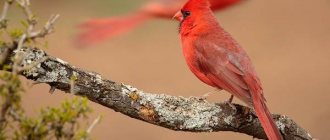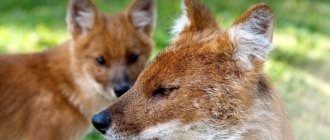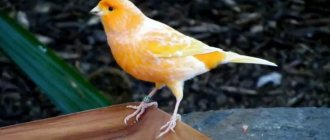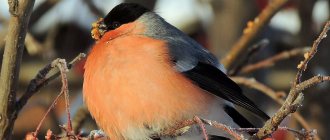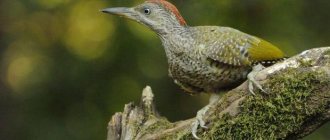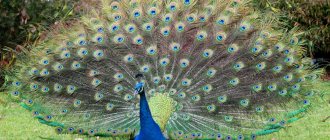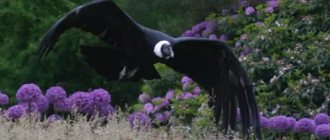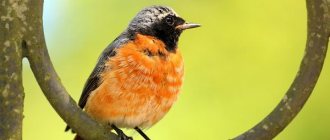The world of birds is diverse and extremely interesting. Nature has tried and worked on their appearance, adapting them to different living conditions. Among them you can find completely inconspicuous representatives, and you can also see those who have taken all the brightest colors for themselves. These are birds with a red beak and a multi-colored tail, and birds with a long beautiful tail, and very small birds with a long beak. Let's find out the names of some of them, details of their appearance, conditions of existence.
Origin of the species and description
Photo: Red Cardinal
The red cardinal (Cardinalis cardinalis) is a North American cardinal bird. It is also known as the northern cardinal. The common name, as well as the scientific name, red cardinal refers to cardinals of the Roman Catholic Church who wear distinctive red robes and caps. The term "northern" in the common name refers to its range, as it is the northernmost cardinal species. There are 19 subspecies of red cardinals, which differ mainly in color. Their average lifespan is approximately three years, although some have a lifespan of 13 to 15 years.
Video: Red Cardinal
The red cardinal is the official state bird of at least seven eastern states. Extensive across the Southeast, it has been expanding its range northward for decades, and it now brightens winter days with its color and whistling song as far north as southeastern Canada. Feeders supplied with sunflower seeds may have helped its spread north. West of the Great Plains, the red cardinal is largely absent, but in the desert southwest it is locally common.
Fun fact: Many people are puzzled every spring when the red cardinal attacks its reflection in a window, car mirror or shiny bumper. Both males and females do this, and most often in the spring and early summer, when they are obsessed with protecting their territory from any intruders. Birds can fight these intruders for hours without giving up. A few weeks later, as levels of aggressive hormones decline, these attacks should stop (although one female maintained this behavior every day for six months without stopping).
Kingfisher singing
Kingfishers are not songbirds, but do make various sounds during hunting or mating season. The common kingfisher has a sharp and sonorous voice; most often you can hear from it the loud squeak of “tiu”, “tiik”, “tiit”, “tiip-teip”. The striped kingfisher makes a continuous "wheeeeeeeeeeeee" sound for about 15 seconds.
But the most unusual sounds from the representatives of the family are reproduced by the kookaburra. We can say that this kingfisher sings even frighteningly, and its screams resemble human laughter. The song starts with a clicking sound and goes into a loud “ha ha ha.” The main reason for the singing of birds of this species is to mark their territory. Often kookaburras even scream in unison.
We invite you to watch the video and listen to the singing of a kookaburra or a laughing kingfisher.
Appearance and features
Photo: What a red cardinal looks like
Red cardinals are medium-sized songbirds. Males are bright red except for a black facial mask. They are one of the most recognizable birds due to their bright red color. Females are light brown or light greenish brown with reddish highlights and do not have a black mask (but parts of their face may be dark).
Both males and females have thick, orange-red, cone-shaped bills, a long tail, and a distinctive crest of feathers on the top of their heads. Males are slightly larger than females. Males are 22.2 to 23.5 cm long, while females are 20.9 to 21.6 cm long. The average weight of adult red cardinals is 42 to 48 g. The average wing length is 30.5 cm. Juveniles red cardinals are similar to females, but have a gray rather than orange-red bill.
Fun fact: There are 18 subspecies of red cardinals. Most of these subspecies differ in the color of the female's mask.
Unlike many other songbirds in North America, both male and female red cardinals can sing. Typically, only male songbirds can sing. They have distinct phrases such as the very sharp "chip-chip-chip" or a long greeting. They tend to choose very high pitches for singing. The male will use his call to attract a female, while the female red cardinal will sing from her nest, perhaps calling to her mate as a message for food.
Fun fact: The oldest recorded red cardinal was a female, and she was 15 years and 9 months old when she was found in Pennsylvania.
Is it possible to keep a kingfisher at home?
Kingfishers are not tame birds. They are not bred for singing and are not raised for commercial purposes. An adult that ends up in a human home will most likely quickly die in captivity - these birds must get their own food, so without fishing they wither away. But you can try to raise a found kingfisher chick at home.
The cage for a bird should be spacious (remember the kingfisher’s love of flying), and it is better to place an adult bird even in an aviary. In addition to the drinking bowl and feeder, the kingfisher must have a large branch in the house, since the bird will spend most of its time on it.
You can immediately feed a young kingfisher in captivity with a mealworm. When the chick grows up, the bulk of its diet should be raw fish.
Micronesian alcyone in an enclosure at the zoo
Where does the red cardinal live?
Photo Red cardinal in America
There are an estimated 120 million red cardinals in the world, with the majority living in the eastern United States, followed by Mexico and then southern Canada. In the United States, they can be found from Maine to Texas and south through Mexico, Belize and Guatemala. They also live in parts of Arizona, California, New Mexico and Hawaii.
The red cardinal's range has expanded over the past 50 years, including New York and New England, and continues to expand north and west. Experts believe this is partly due to the increase in cities, suburbs and people providing food year-round, making it easier for them to survive in colder climates. Red cardinals tend to live in dense vegetation such as forest edges, overgrown fields, hedgerows, wetlands, mesquite and ornamental landscapes.
Thus, red cardinals are native to the non-Arctic region. They are found throughout eastern and central North America from southern Canada to parts of Mexico and Central America. They have also been introduced in California, Hawaii and Bermuda. Red cardinals have expanded their range significantly since the early 1800s, taking advantage of moderate temperatures, human habitation, and the additional food available at bird feeders.
Red cardinals prefer forest edges, hedges and vegetation around houses. This may be part of the reason for their increase in numbers since the early 1800s. Red cardinals also benefit from large numbers of people feeding them and other seed-eating birds in the backyard.
Now you know where the red cardinal is found. Let's see what this bird eats.
Legends about the stork
The name of the bird with a red beak and white plumage appears in many beautiful ancient legends and tales. Since time immemorial, the white stork has been considered a rather revered bird, and it has been associated with prosperity, well-being, good luck and a happy life. There are also many good tales and legends associated with him, both in the East and in Europe, and everywhere he acts as a protector from any evil spirit and as the keeper of the family hearth, bringing happiness.
It was believed that a family whose house a stork flies to will definitely have a long-awaited child, and therefore many families without children relied on the help of this bird.
According to folk legends, God endowed this bird with white plumage, and the devil with black wings, which is why it symbolizes the endless struggle between good and bad, between good and evil.
What does the red cardinal eat?
Photo: Red cardinal bird
Red cardinals are omnivores. The typical diet of a red cardinal consists primarily of seeds, grains and fruits. Their diet is also supplemented by insects, which are the main source of food for their chicks. Some of their favorite insects include beetles, butterflies, centipedes, cicadas, crickets, flies, katydids, moths and spiders.
During the winter months they rely heavily on seeds supplied in feeders, with butter sunflower seeds and safflower seeds being their favorites. Other foods they enjoy include dogwood, wild grapes, buckwheat, grasses, sedges, mulberries, blueberries, blackberries, sumac, tulip tree and corn. Blueberry, mulberry and blackberry plants are excellent options for planting as they provide both a food source and cover due to their bushiness.
To maintain their appearance, they consume grapes or dogwood berries. During the digestion process, pigments from fruits enter the bloodstream, into the feather follicles and crystallize. If the red cardinal cannot find berries, its hue will gradually begin to fade.
Fun fact: Red cardinals get their bright colors from pigments found in the berries and other plant materials in their diet.
One of the most important things you need to attract red cardinals is a bird feeder. Unlike many other birds, cardinals cannot change their direction quickly, so bird feeders must be large enough for them to land easily. They want to feel protected while they eat, so it is best to place the feeder about 1.5-1.8 m above the ground and near trees or shrubs. Red cardinals are also ground feeders and will appreciate food being left under a bird feeder. Some of the best options for bird feeder styles include feeders with a large open seating area.
Red cardinals use the bathhouses for both drinking and basking. Due to the size of most cardinals, it is best to have a birdbath that is 5 to 8 cm deep at its deepest point. In winter, it is best to do a hot bird bath or immerse the heater in a regular bird bath. Bathing water for any type of bird must be changed several times a week. If a water source is not displayed, red cardinals will need to leave and find it elsewhere, such as a local pond, stream or river.
Bottom line
Thus, a huge number of bird species are included in the Red Book of Russia. Some of them live in small populations and can be observed in different parts of the country, and some birds have been little studied. Unfortunately, a certain number of species are on the verge of extinction and it is almost impossible to preserve them on the planet. There are many reasons for the disappearance of birds. This includes water pollution, destruction of wild areas, and poaching. At the moment, the maximum number of bird species is under state protection, but this is not enough to preserve and restore the populations of many rare bird species.
Features of character and lifestyle
Photo: Red cardinal in winter
Red cardinals are not migratory, but are year-round residents throughout their range. They are active during the day, especially in the morning and evening hours. During the winter, most cardinals flock and live together. During the breeding season they are quite territorial.
Red cardinals prefer a secluded place where they feel safe. The type of areas that provide excellent coverage are dense vines, trees and shrubs. There are many types of trees and shrubs that red cardinals are drawn to for nesting purposes. Planting shrubs such as grapevine, honeysuckle, dogwood and juniper can provide ideal cover for their nests. In winter, evergreen trees and shrubs provide safe and adequate cover for these non-migratory birds.
Red cardinals do not use birdhouses for nesting. Instead, the male and female will look for a densely covered nest a week or two before the female begins to build one. The actual location tends to be where the nest is wedged into a fork of small branches in a shrub, sapling, or tangle. The nest is always hidden in dense foliage. The most common trees and shrubs selected by red cardinals include dogwood, honeysuckle, pine, hawthorn, vine, spruce, hemlock, blackberry, rose bushes, elms, elderberries and sugar maples.
Fun fact: Female red cardinals are responsible for nest building. They usually build nests from twigs, pine needles, grass and other plant material.
Once a location is chosen, the male usually brings nesting materials to the female. These materials include strips of bark, coarse thin twigs, vines, grasses, leaves, pine needles, plant fibers, roots and stems. The female crushes the twigs with her beak until they become flexible, and then pushes them with her paws, creating a cup shape.
Each nest has four layers of rough twigs that are covered with a leaf mat, lined with vine bark, and then trimmed with pine needles, grasses, stems, and roots. Each nest takes up to 10 days. Red cardinals will only use their nesting site once, so it is important to always have plenty of trees, bushes and materials nearby.
Oystercatcher habitats
These birds with large red beaks are both migratory and non-migratory. They settle on the coasts of lakes and rivers. In winter, they prefer not very cold places: the Mediterranean and Atlantic coasts. They choose places for nesting that provide good food for their young. To a greater extent, these are pebble and sandy shores, and sometimes they settle in rocks.
Oystercatchers arrive in Russia in early May. For the winter they fly towards the northern part of Western Europe: to France, Denmark, Germany and Holland.
Social structure and reproduction
Photo: Male and female red cardinal
In southern areas, red cardinals are known to raise three broods in one season. In the middle states they rarely breed more than one. Red cardinals are exceptional parents. The male shares parental responsibilities with his mate, with feeding and care left to the mother during and after incubation. His paternal instincts help him protect his mother and children until they leave the nest.
Young red cardinals often follow their parents on the ground for several days after leaving the nest. They stay very close to their parents until they are able to forage for food on their own. While the male is caring for his family, his bright red color often changes to a dull shade of brown.
The mating seasons for red cardinals are March, May, June and July. Clutch size is from 2 to 5 eggs. The egg is 2.2 to 2.7 cm long, 1.7 to 2 cm wide, and weighs 4.5 grams. The eggs are smooth and glossy white with a greenish, blue or brown tint, with grey, brown or reddish speckles. The incubation period ranges from 11 to 13 days. The cubs are born naked except for occasional tufts of grayish down, their eyes are closed, and they are clumsy. Life stages of young red cardinals:
- cub - from 0 to 3 days. His eyes haven't opened yet, there may be tufts down his body. Not ready to leave the nest;
- chick - from 4 to 13 days. Its eyes are open and its wing feathers can resemble tubes because they have yet to break through their protective membranes. He's also still not ready to leave the nest;
- young - 14 days and older. This bird is completely feathered. Her wings and tail may be short and she may not have mastered flight yet, but she can walk, jump and flutter. She has left the nest, although her parents may be there to help and protect if necessary.
Legends of the Kingfisher
Many legends are associated with these birds. According to Japanese legend, the kingfisher and sparrow were once brothers. The parents sent the grown birds to the city to earn money, where the sparrow worked hard, and the kingfisher only had fun and dressed up beautifully. After some time, the news came that the parents had died, and the sparrow quickly rushed to the funeral, but the bright dandy was late, as he had been choosing an outfit for a long time. Everyone put the kingfisher to shame, and since then he has been hiding in secluded corners and is rarely seen.
There is another legend, a Christian one. Noah sent a kingfisher and a dove to search for land. The Fisher King was overtaken by a storm, and he rose higher and higher. There, in the blue of heaven, the bird colored its wings azure blue, and when it flew to the sun, it scorched its breast, and it became orange. Having descended back to the sea, the kingfisher did not find the ark, and since then it has been flying over the water.
In ancient Greek mythology, Alcyone, the daughter of Aeolus, upon learning of the death of her husband Keik at sea, threw herself into the depths of the sea. The husband and wife turned into kingfishers. It is believed that during the two-week calm that sets in on the Aegean Sea (before and after the winter solstice), the bird nests. And in Russian art, based on this myth, the Alkonost bird appeared, with the hands and head of a woman.
Mythical bird Alkonost - kingfisher in Russian art
In many European countries, the kingfisher is considered a bird that brings good luck:
- in Germany, birds are a symbol of wealth and prosperity, so people want to have stuffed kingfishers in their homes;
- in Italy and France, these birds are more often called birds of paradise and photographs of them are hung in homes for good luck.
Natural enemies of red cardinals
Photo: What a red cardinal looks like
Adult red cardinals can be eaten by domestic cats, domestic dogs, Cooper's hawks, northern shrikes, eastern gray squirrels, and long-eared owls. Chicks and eggs are vulnerable to predation by snakes, birds and small mammals. Predators of chicks and eggs include milk snakes, black snakes, blue jays, red squirrels, and eastern chipmunks. Cow moths are also capable of stealing eggs from a nest, sometimes eating them.
When confronted by a predator near their nest, male and female red cardinals will give an alarm call, which is a short, shrill note, and will fly towards the predator in an attempt to scare it off. But they do not aggressively crowd with predators.
In summary, the known predators of red cardinals are:
- domestic cats (Felis silvestris);
- domestic dogs (Canis lupusiliaris);
- Cooper's hawks (Accipiter cooperii);
- American Shrike (Lanius ludovicianus);
- northern shrike (Lanius excubitor);
- Carolina squirrel (Sciurus carolinensis);
- long-eared owls (Asio otus);
- eastern owls (Otus asio);
- milk snakes (Lampropeltis triangulum elapsoides);
- black snake (Coluber constrictor);
- gray climbing snake (Pantherophis obsoletus);
- blue jay (Cyanocitta cristata);
- fox squirrel (Sciurus niger);
- red squirrels (Tamiasciurus hudsonicus);
- eastern chipmunks (Tamias striatus);
- brown-headed cowtail (Molothrus ater).
Original English names
Well, we, breeders, love names for pets with an English slant. And nothing can be done about it. Therefore, add original English names for birds to your collection.
- Krosh
- Troy
- Kaid
- Eminem
- Kala
- Kong
- Kylie
- Suga
- Valmont
- Uttar
- Terro
- North
- Devi
- Yanda
- China
- Town
- Bacon
- Adele
- Lemur
- Brian
- Hayato
- Magic
- Amber
Owl Rozarka looks like it’s straight out of a fairy tale
- Rive
- Rhine
- Stone
- Merle
- edge
- Hai
- The battle
- Chief
- Bos
- Colitis
- Fox
- Mouse
- Fisher
- Fish
- Thorn
- Field
- Beach
- Garbage
- Grasse
- Bodice
- Spice
- Piper
Inseparable friends
- Scoush
- Peach
- Lemon
- Grasse
- Juice
- Ban
- Bol
- Rainboil
- Balun
- Brush
- Wil
- Willow
- Neil
- Clyde
- Fog
- Moon
- Weather
- Daps
- Hythe
Beautiful bird with a crest - blue jay
This bird stands out among all birds with its long blue tail and the same bright blue crest. The habitat of this colorful bird of the corvid family is North America. They live in pairs or small family flocks, but during migration they form large groups.
Birds are distinguished by their ability to make unusual sounds and imitate the voices of various birds, including numerous predators from whose attacks they suffer. This allows them to warn their relatives about danger, as well as scare away other predators that have invaded their habitat.
Blue jays do not migrate and, as a result, are required to store supplies for the winter. And usually a jay prepares about 3-5 thousand acorns. Moreover, an interesting fact is that at one time these birds can bring 5 acorns - 2-3 pieces in the crop, one more in the mouth and one in the beak.
Mythical Bird of Paradise
Birds of paradise, heroes of various myths and fairy tales, are actually the closest relatives of the familiar crows and sparrows. These beautiful and positive birds live on the islands in New Guinea and number as many as 45 species.
Due to such a huge number of species of birds of paradise, it is simply impossible to create any kind of holistic image of them. Some individuals have bright plumage, most often in red, blue and yellow colors. Others have brightly colored plumage on their heads that makes them stand out from other bird species. And still others have a bright fluffy tail. To fully describe their unusual characteristics, it is worth citing several different representatives of these positive birds. And then everything will become clear to everyone.
- The ribbon bird of paradise has the longest tail, which is three times the length of the bird's body itself.
- The blue bird of paradise shows its unusual plumage only during mating displays and upside down
- The six-feathered bird of paradise has six feathers on its head, comparable to the length of the bird's entire body, with tassels at the ends
- Wilson's Royal Bird of Paradise has an unusual tail with feathers curled inward.
Hoopoe - a colorful swear word with an interesting beak
How often have we heard the phrase “What a hoopoe you are!”, which served as a sarcastic perception of you in the eyes of others. However, this may actually be a valuable compliment, since this bird is actually one of the most bizarre of all birds.
Outwardly, the hoopoe looks awkward - it has a small body with a funny crest on its head and a huge elongated beak. At the same time, he not only flies quickly, but also runs perfectly on the ground. In addition to their gorgeous red crest, hoopoes have large black and white striped wings. At the same time, the entire body of the hoopoe is covered with red feathers.
The population of these birds in autumn is extensive. They can be seen in Portugal and Finland, China and India, on the African continent and in Siberia. Hoopoes will always prefer to settle in an open area among small trees rather than choose a large noisy forest. It is especially worth noting this interesting feature. If the hoopoe is overtaken by danger on the ground, then it takes an unusual pose - it presses against the ground, spreading its wings wide and sticking its beak up.
Coconut octopus
This octopus lives in the tropical waters of the Pacific Ocean, hunts shrimp, shellfish, crabs and behaves unusually: it uses two limbs to walk.
He also uses coconut shells to create a home. The octopus finds the halves of a coconut that have fallen into the sea: it places its body inside one half, and covers the other half on top.
Golden pheasant - a symbol of dignitaries in Ancient China
This most colorful member of the pheasant family is native to the highlands of subtropical China. And the most favorite place for their settlement is bamboo thickets near the foot of the mountains. In the wild, they are most often accustomed to living alone or in small groups.
Now this bird is one of the most popular in pheasant farming. And they gained such popularity due to their beautiful wide crest, long mantle collar and bright tail, which consists of 18 tail feathers. Such bright coloring and beautiful plumage allowed the golden pheasant to rightfully bear the title of one of the most beautiful birds.
Interesting fact. Despite the fact that these birds can fly, when danger arises, they prefer to flee and only in extreme cases fly up onto branches.
